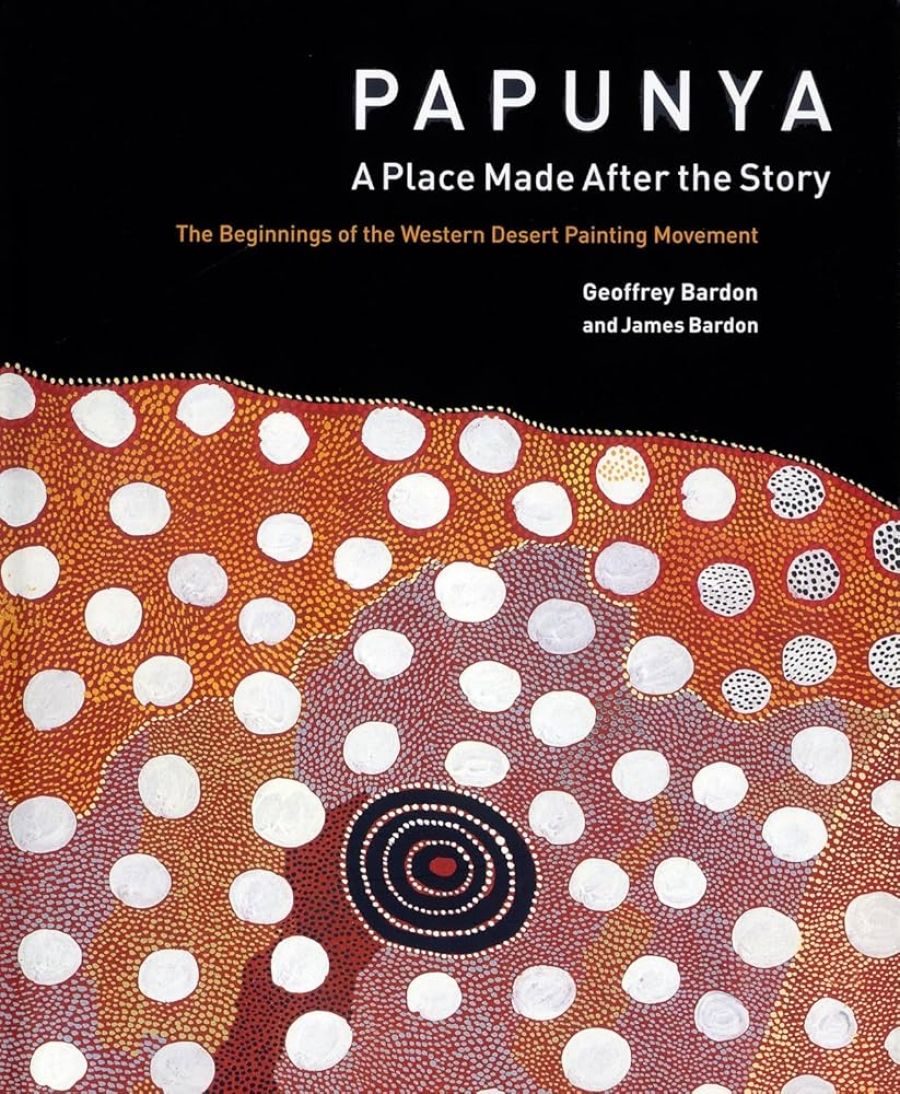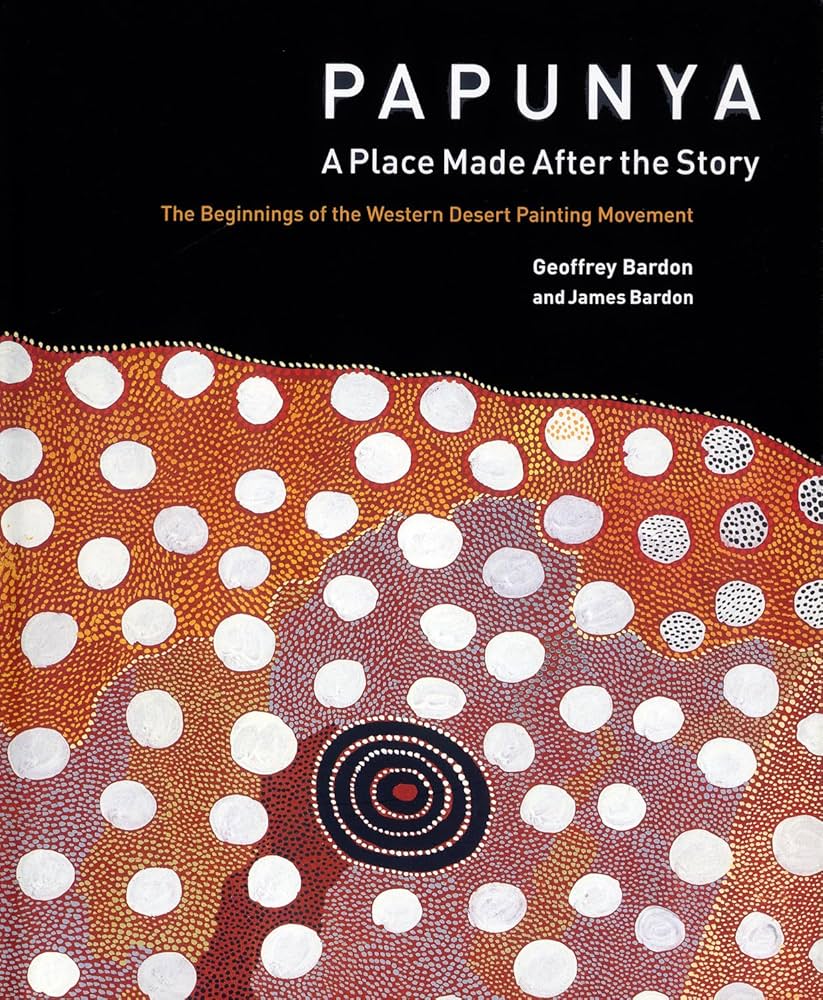
- Free Article: No
- Contents Category: Art
- Review Article: Yes
- Article Title: The Art Master
- Online Only: No
- Custom Highlight Text:
Geoffrey Bardon spent just two and a half years, from the start of 1971 until mid-1973, at Papunya, 200 kilometres west of Alice Springs. While he was there, teaching art and craft as well as social studies, Aboriginal art changed. A group of Aboriginal men began painting with Western materials, transferring versions of their traditional sand designs onto boards in a way they had not before, or not in that quantity. One of the biggest questions about Bardon is how much he mattered to this new art – at crudest, would Papunya painting have happened without him?
- Book 1 Title: Papunya: A place made after the story
- Book 1 Subtitle: The beginnings of the Western Desert painting movement
- Book 1 Biblio: MUP, $120hb, 552pp, 0 522 85 110 X
- Book 1 Cover Small (400 x 600):

- Book 1 Cover (800 x 1200):

A key issue for Papunya painting is whether it started before Bardon arrived there. The sources are thin. Vivien Johnson has reported that there were Papunya artists ‘who were experimenting with paintings based on traditional Western Desert motifs during the late ’60s’. An earlier teacher there remembered such paintings ‘appearing occasionally’. But none of these pictures has been located, and Johnson suggests they may have been ‘destroyed at the time by their creators’. No one, it seems, thought to ask the artists.
The sources for what followed are much thicker, but only because of Bardon. He began describing his experiences in 1979, in Aboriginal Art of the Western Desert, which ran to just seventy-two pages. He followed in 1991, with Papunya Tula: Art of the Western Desert, which was double the size. Now we have the 527-page Papunya: A Place Made after the Story, published a year and a half after Bardon’s death, with his brother James on the title page as an author but no explanation of the extent of his contribution to the book.
These three accounts all tell what has become the classic Papunya story. It starts with Bardon getting Aboriginal children to paint murals on the school walls. Then Aboriginal men offer to help and, before long, take over, culminating in a ‘feature mural’ of the Honey Ant Dreaming by Kaapa Tjampitjinpa, which initially included European-style ants and birds but was completed with traditional Aboriginal designs. Soon there are artists everywhere, plying Bardon for brushes, acrylic paints and boards. He establishes a painting room for them. He uses his combivan to take their pictures to Alice Springs for sale, changing the men’s identity and economy, while retaining no payment for himself.
Yet Bardon’s books also provide very different accounts of what happened. These differences are partly a function of length – of Bardon having more and more space to write. But they are also due to his gradually admitting or claiming a much larger role for himself in what occurred. They are also due to his developing a different voice. Where he began by writing simple, if sometimes contradictory, prose, he ended up writing something much more like poetry. There is a rare intensity about Bardon’s best writing, a palpable sense of struggling to convey profound, awesome, epic events. If anyone compiles a book of religious writing in Australia, they should include a slice of Bardon. When Bardon first wrote about the Honey Ant Mural, as he originally described it in Aboriginal Art of the Western Desert, he played a very modest role in Kaapa’s painting process. When Kaapa began to include ants and birds painted in a European manner, Bardon wondered why he chose ‘this style of realism as opposed to traditional Aboriginal abstract designs, and talked with Kaapa and the other men about this’. The implication was that he questioned them, nothing more, and, after the Aboriginal men conferred, they painted over the European ants and birds.
Bardon’s account of his role in the paintings on board was similar. While he likened himself to an ‘agent’ or ‘gallery owner’ for the painters – emphasising that these intermediaries often ‘interpret an artist’s paintings to the public, and conversely will assist an artist in developing his style by telling him what appeals most to the public’ – he went on to stress the modesty of this assistance. He wrote: ‘Often the painters invited my advice or comments. Usually their only difficulty was adapting their style to rectangular pieces of board … I was always conscious that I must not intrude my own opinions about colours, methods, and subject matter, and I acted rather hesitantly in my advisory capacity.’ Yet the account that followed was of something very different. He was ‘fascinated’ by the Aborigines’ ‘graphic symbols and motifs and their validity as simplifications as perceived objects’ and ‘did not want them to be changed and advised against “whitefellow” elements or themes’. He ‘constantly suggested that the painting men should paint many different stories’ and ‘often suggested topics’. He advised the painters to ‘use traditional ochre colours’ and to avoid colours that ‘were clearly European: green, blue, purple’.
It is an account in which these specifics of what Bardon told the painters to do and not to do are more cogent than the generalities. His regard for the traditional, it suggests, made him reluctant to intervene and spurred him to do so when he thought the artists were departing from their own traditions. Despite his denial, Bardon’s first book suggested that he was constantly expressing his ‘opinions about colours, methods, and subject matter’ and, by implication, wielding great influence. If he was an agent, he was an active one.
Papunya Tula: Art of the Western Desert was in many respects similar. Bardon continued to describe himself as an agent and dealer, as well as ‘a friend, a contact, a customer’ and ‘perhaps most importantly … a supplier of painting materials’. He emphasised his anxiety not to exercise white power: ‘I did not want a hierarchy of skin colors’, he wrote of his work in the classroom. He also revealed himself repeatedly using his position, writing, for example, that by his ‘insisting on slow, careful work with good stories, the men developed an inspired concentration’. Yet his narrative in this second book involved even more internal inconsistencies. On the one hand, he wrote: ‘For all of them, painting seemed to be a primary form of self-expression, so it was hard for me (practically and in conscience) to show any preferences.’ On the other hand, he had himself repeatedly identifying what he liked and the artists responding ‘to any praise I would give them’ because, as he immediately explained, he valued the paintings and his attitude ‘of course affected the price’.
He also gave a very different account of the painting of the Honey Ant Mural to that in his first book. Far from simply raising the issue of the use of European imagery in the mural, he described himself as having stopped it. Bardon wrote: ‘I decided to intervene in what was being done. I pointed at the wall and said to this Kaapa … “Are these ants proper Aboriginal honey ants? Nothing is to be whitefellow.”’ This intervention was decisive. Kaapa looked at Bardon ‘for a second and went across to Bill Stockmen and Long Jack. After a few whispered words he came back and took up his brush and made the honey ant figure, or hieroglyph, then made the travelling marks around the true honey ant.’
Bardon’s posthumous book, Papunya: A Place Made after the Story, is riddled with the same tensions. Bardon begins modestly by referring to his ‘association’ with the painters and ‘presence’ at ‘the beginning of the movement’. He gives no hint that he was an active agent, let alone a formative force. Yet he goes on to make his biggest claim: ‘I believe that the painters trusted me, even loved me in their own way, and without that trust of so many knowledgeable and intelligent men, that Western Desert painting might have been very different or not at all.’
Bardon similarly goes further than ever in describing how he shaped the artists’ work by ‘suggesting’, ‘asking’, ‘exhorting’, ‘pleading’, ‘disciplining’ and ‘intervening’. He was involved at all points of a painting’s production, even when the artist ‘thought his work was “finished” and had “to come forward” and “ask for guidance”.’ He also made the last judgment. He writes: ‘I was constantly involved in a process of selection concerning which paintings to accept and which to reject, for I rejected many paintings, some by the finest artists, as being poorly conceptualized, spatially or stylistically.’
Bardon writes that the artists sometimes adopted his ideas more or less readily. The omission of sacred, secret material from the paintings, one of Bardon’s prime concerns, was ‘the easiest part’ of their interaction. He also suggests that at least some of the painters enjoyed engaging with him as the art master. When he embarked on ‘a vigorous analysis of what a painting meant’, his prime criterion for judging a work, it was something ‘the artists seemed to appreciate … particularly the gifted artists’.
Yet Bardon also goes furthest in revealing the limits of his influence. When he asked an artist to tell a story for him or to stop work, ‘Of course, this was not always what occurred and the painters would be themselves, or with me, seemingly do exactly as they wished’. The same was true when he tried to ‘impart a sophisticated argument for or against the use of the material in a certain way, since for the most part my Pintupi was not up to it’. He acknowledges: ‘Perhaps even with my interpreters my many requests simply did not get through.’
The sharpest illustration of this failure to communicate concerns Bardon’s decision to establish the artists’ organisation Papunya Tula. Bardon recounts that as he drove to Alice Springs to establish the company with Tim Leura Tjapaltjarri and Billy Stockmen Tjapaltjarri, he ‘talked with the men about what we were going to do’. They talked more with a solicitor. Bardon was confident he had their informed consent. Then a translator became involved. Bardon writes: ‘I was amazed to learn that neither man had understood why I had brought them to Alice Springs, or what I said in the car, or what happened in the solicitor’s office, or fully anything about the Aboriginal company.’ This incident, more than any other, raises doubts about how well Bardon and the artists understood one another.
Whether accidentally or deliberately, Papunya: A Place Made after the Story makes all this plain. There is no attempt to paper over the cracks in his account – to reduce turbulence to order. This turbulence is vital to what Bardon describes at the end of his main essay as the ‘fierce struggle for the men and me in disciplining the paintings and without interfering with or changing their souls’. Read this book not for a clear chronicle of what happened but for how it felt as Bardon lived with these experiences for the rest of his life.


Comments powered by CComment